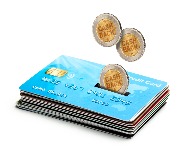Transfer Balance To 0% And Dodge The Fee!

Find out the real cost of balance-transfer fees, and learn how you can TRULY borrow for free!
Credit-card companies are more sneaky than Gollum. By promoting 0% balance-transfer cards in huge letters and burying the fee, they deceive people into thinking the cards are totally free until it's too late.Most Fools won't fall for that old trick, but in addition the fees themselves are deceptive and make the credit cards difficult to compare with standard deals that charge interest. I'm going to show you why, and how you can offset the fee completely, so you actually pay nothing!The true cost of the feeTypically, we are charged a fee of 2-3% on debts transferred to credit cards in return for 0% interest for an agreed period. However, when you pay the fee, you pay the whole of it up front on the entire balance. Compare this with paying interest: when you do that, you pay the APR (annual percentage rate) over a year, not up front. To put this another way, you pay less than 1/12 of the interest rate in the first month, and even less in following months, assuming you're steadily paying off your balance.So a 2% fee does not equal 2% APR. Take a look at this table:Balance-transfer fees expressed as interest(This is based on a transfer that is fully repaid in equal instalments by the end of the 0% deal.)Interest-free periodFee of 2%Fee of 2.5%Fee of 3%6 months7.0% AER8.9% AER10.7% AER9 months4.9% AER6.1% AER7.4% AER12 months3.7% AER4.7% AER5.6% AERSource: M&S MoneyThis table show that, if you pay a fee of 2% and clear your balance steadily throughout the introductory period, it's the equivalent of paying interest at about 4-7%. For a credit card with a 3% fee you'll pay the equivalent of around 6-11%. The shorter the deal and the higher the fee, the higher the equivalent interest rate. Even so, these figures are still better than the default interest rates on your average credit card, which is shockingly high at around 16%. The interest rates above are more comparable with unsecured personal loans, which you can get for 6% or 7% at present, or to lifetime balance-transfer cards.Also, as you'll see, a 12-month deal with a 2% fee is a bit like paying 3.7% interest, which is virtually unbeatable. However, there is a way to offset even this small amount, and perhaps even make a profit from your borrowing.Pay truly nothing on your balance transfer!There is a way to totally wipe out the cost of the fee, so that you really do pay nothing. What you do is you don't pay off the balance in equal instalments. Instead, you just make the minimum monthly repayment to the credit card, and you put the difference into a savings account. One month before the introductory deal expires, you transfer the money back into your current account and then pay off the debt completely.Running some quick figures, I see that for a basic-rate taxpayer who has a decent savings account (so, receiving about 6% interest per year before tax, 4.8% afterwards) you should pretty much break even with a 12 month/2% fee card.Here are the numbers. A £3,000 balance, plus 2% fee, which is £60, brings the total to £3,060. That's £255 per month in your savings account, less the minimum monthly payment to the card (typically 2-3%). you'll earn around £60 in savings interest. This means you've borrowed £3,000, paid £60 and earned £60ish, so you've actually borrowed £3,000 and paid nothing!What's interesting is that you'll be even better off with some of the newer credit cards on the market, which charge higher fees but the deals last longer. Take Barclaycard's Platinum Credit Card, for example. This has a 14-month deal with a 2.5% fee. If you borrowed £3,000, the fee would be £75 and the total £3,075. You could actually earn tens of pounds more than you would with a 12-month/2% fee deal, putting you in profit. What's more, it'd be easier to do, because you'd only have to find £220 per month, rather than £255. Higher-rate tax payers may also be able to break even with cards like this too!> Read more about lenders' Gollum tactics in Credit Cards With Small Print And Big Fees.Most Recent
Comments
Be the first to comment
Do you want to comment on this article? You need to be signed in for this feature







